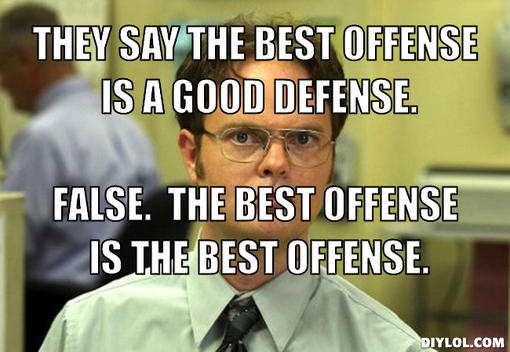Steal This Drill: Offense Defense
 Wednesday, February 1, 2012 at 07:19AM
Wednesday, February 1, 2012 at 07:19AM  CAtennis
CAtennis  In the fields of athletic competition, war and, sometimes, business it is often said that "the best offense is a good defense". Of course, when it comes to putting the ball away in tennis, being the master of defensive shots is often not enough. Many times, players work the point to perfection, get an easy sitter in the middle of the court and then fail to convert on the occasion. Whether they overhit, underhit or it the ball right to the opponent, these players could be well-served by practicing some offense-defense type drills.
In the fields of athletic competition, war and, sometimes, business it is often said that "the best offense is a good defense". Of course, when it comes to putting the ball away in tennis, being the master of defensive shots is often not enough. Many times, players work the point to perfection, get an easy sitter in the middle of the court and then fail to convert on the occasion. Whether they overhit, underhit or it the ball right to the opponent, these players could be well-served by practicing some offense-defense type drills.
Here's a good and SIMPLE drill that two players (or a player and coach) can incorporate in their practice in order to develop the ability to "pop" the ball. One player (the practice partner) stays in one half of the court and simply moves the opponent (the "principal") side to side with SOFT, medium-height shots (i.e. balls should bounce above 6ft). The principal tries to thump these balls back to the practice partner with hard, penetrating shots. By performing this drill, the principal learns how to move his feet for the ball, load his body weight and also generate racket head speed. Remember that the practice partner is not generating any pace (he simply blocks the ball back - hence the "defense" in the name of the drill) so all the pace is provided by the principal. The principal goes to the point of exhaustion (up to 3 minutes is good; beyond 3 minutes it's great). Thereafter, the players switch roles so each gets a chance to dictate. Sprinkle this drill throughout your workouts and very soon you will master the put-away shot. By hitting these shots with confidence, your whole game will change. You will hit more winners (from an optimal court position); you will force the opponent to go for more on regular shots (since she knows that if she gives you the floater you will put the ball away); and you will develop a more aggressive instinct.

